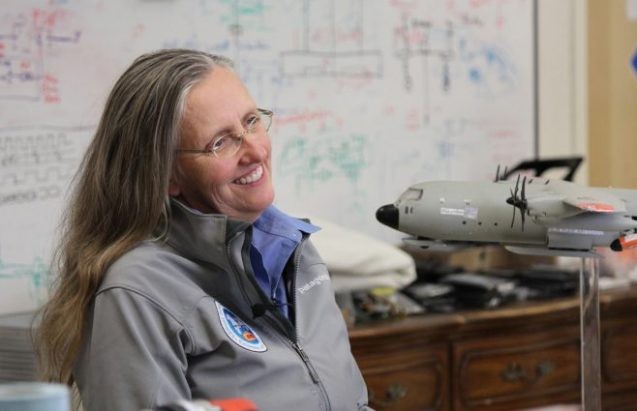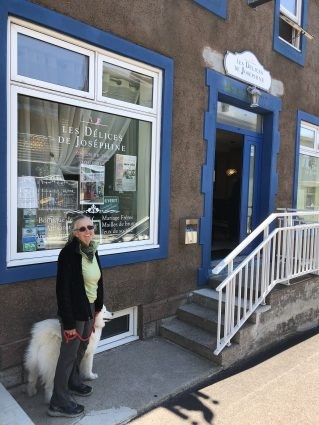On Carbon, Geophysicist Robin Bell Walks the Walk
The world’s leading earth scientist is not allowing collective inaction to absolve her of personal responsibility.

Robin Bell is a renowned geophysicist, the natural science which concerns itself with the physical processes and properties of the Earth. She has accumulated many accolades for her discoveries in Antarctica and Greenland, which include sub-glacial lakes, rivers that flow uphill, and a volcano beneath the West Antarctic ice sheet.
Bell is a research professor at Columbia’s Lamont-Doherty Earth Institute and the current president of the American Geophsyical Union. As the president of the world’s largest organization of earth and space scientists—the AGU includes 62,000 scientists from 144 countries—she is the de facto top earth scientist in the world. The sensitive polar regions Bell studies are warming quickly, a symptom of climate change wrought by emissions from mankind’s activities. She is acutely aware of her personal contributions to the problem: her fuel-intensive polar research and a demanding travel schedule.
For many Americans, even those convinced of the science, climate change is a problem requiring collective action and thus excuse themselves from making personal sacrifices to reduce their personal emissions. Some say individual efforts to curb climate change, like eating less meat or cutting down on their air travel, are largely symbolic and too small to make any meaningful impact. It is notable, however, that the world’s leading earth scientist is not allowing collective inaction to absolve her of personal responsibility.
A Profile of Robin Bell
It is a frigid winter day at the Lamont-Doherty Earth Observatory on the Hudson River. Ice and salt still crystallize the pavement from the last storm, so Bell drove her silver Prius to work. I follow the sound of laughter on the first floor of the Oceanography building and run into Bell at the end of the hall. She offers me loose tea and invites her dog, Nara, a fluffy white Samoyed, to join us in her office overlooking the river.
Bell lives ten miles from the research center where she has worked to advance polar science over the past 35 years. According to Bell, the fossil fuel that supplements her hybrid vehicle will be her largest personal carbon expenditure until a flight to Asia later this year. In better weather, she cycles, or rides her electric bicycle.
Bell talked me through the weeks of her 2018 carbon emissions, which she tracked and charted as a line graph on her computer. She lamented the flight to Mexico that caused the line to spike and noted where it leveled out during carbon-negligible weeks where she and her husband, environmental law professor Karl Coplan, were sailing. “Nine tons. I’m still below average, but boy this year I’m going to blow it through the roof with travel.”

Bell’s role as the head of the AGU demands her presence at engagements in countries far from her home base in New York. But she will plan her trips with the precision of a military movement, combining multiple trans-Pacific trips to fulfill her presidential duties and to visit her daughter in California into one condensed itinerary.
Her presidency, which began in 2019, comes as the international community wrestles with how to quickly decarbonize the world economy. Staving off the worst effects of climate change requires immediate global-scale reduction in greenhouse gas emissions. The United States, the world’s largest per capita emitter, has sidelined itself from participating in the global effort, handicapped by its own recalcitrance.
Amid the political paralysis in America, debate has emerged among environmentalists and green-leaning citizens between individual versus collective action to curb emissions.
In a December 2017 essay, David Roberts, a prominent climate and energy journalist for Vox, wrote, “Go forth and be green. You will be happier and healthier. But do not mistake it for a solution to climate change. Only collective action and collective ingenuity can save us.”
Roberts’ view exposes a sentiment that is ubiquitous, even among many who study or write about earth science: that change is necessary on a scale far greater than could possibly be affected by any personal sacrifice, so why bother?
Roberts continued the thought in a recent Twitter thread: “Climate change is not an “environmental problem.” It’s far deeper than that. Solutions require basic changes in technology, law, and infrastructure, none of which is affected by individual behavior…Personal asceticism is largely irrelevant.”
The world’s top earth scientist disagrees.
“If we do not start acting like we care about our planet future’s then we can never move toward being a sustainable species,” Bell told me. “We cannot simply blame others and wait for some policy solution. All actions matter. Engaging all the strategies from individual action to carbon sequestration is essential to keep our planet, our home habitable.”
“I just want to set an example. If I am telling people this is an issue, I should be acting like it’s an issue.”
Living life in a manner that comports with her field of study is essential for Bell: “I just want to set an example,” she said. “If I am telling people this is an issue, I should be acting like it’s an issue.”
Bell usually stops by the farmer’s market on her way to the office. Buying from her local growers is an act of community for her. Bell and Coplan also belong to a community-supported agriculture group, whereby members purchase a share of the harvest of local farms to distribute the risk of farming.
Bell and Coplan have adopted a similar strategy for home energy supply, buying into community solar power. “It’s kind of like a CSA for solar,” Bell said. For her and Coplan, it is a work-around strategy, since their home is in the woods and shaded much of the day by tall trees. “We haven’t been willing to cut all the down trees that keep our house cool to get better solar.”
The pair eat a Mediterranean diet—a mostly plant-based approach to food. They keep a garden, too. Bell primarily does the perennials and tends the bees, while Coplan oversees the annuals. Coplan also maintains a sustainable living blog and is the author of the forthcoming book, Live Sustainably Now: A Carbon-Sustainable Vision of the American Dream. Last fall The Hill ran an op-ed where Coplan urged Americans to make fundamental lifestyle changes, “there is no argument for inaction … collective action starts with individual action.”
Their shared passion is sailing, a wind-powered hobby. Bell and Coplan constructed a boat together while they were students at Middlebury College in Vermont. With their two children, they have completed multiple trans-Atlantic voyages and have planned a circumnavigation of the globe. They also maintain a cabin upstate, completely off the grid, with plug-ins to charge their vehicle. “It’s just like a boat,” Bell says. “The batteries are in the floor. It’s a composting toilet. Just a wood stove for heat.”
I asked Bell about the last time she used a plastic bag. Expecting a figure on the order of decades, she replied, “I still read the regular old paper and they come in plastic bags when they are hand-delivered to your house.” Bell is hyper-aware of her impact, but she is not ascetic in her lifestyle. Supporting print journalism, for Bell, is a concession which outweighs the plastic cost. “On my list of things to worry about, plastic bag use isn’t my highest. My carbon use is. I’m much more worried about that. People get worried about plastic straws and don’t have a bigger vision of what their impact is on the planet.”
Bell reflected on fellow leaders in the earth science field, “We should be showing that we are taking sustainability seriously. Very few people are being reflective. Maybe people have done something like dropped beef. Some of my favorite friends here, that’s what they’ve done. But they still fly to an island several times a year.”
Bell proudly points to the new AGU headquarters, the flagship building of science, as an example of what can be accomplished on a macro level. It is the first renovated net-zero building in Washington, DC. It uses rooftop solar, a green wall, auto-tinting glass, and a sewer heat exchange system to offset the energy it uses. “It’s showing what you can do as an individual. This is how we start to say what the future can look like and have it be a positive view.”
Peter Deneen is a graduate student of Climate & Society at Columbia University. He is a former Coast Guard officer and native Californian.
A version of this post was originally published on GlacierHub.GlacierHub is managed by Ben Orlove, an anthropologist at the Earth Institute and the Center for Research on Environmental Decisions at Columbia University.
